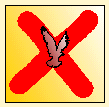
HEN HARRIER. Circus cyaneus
IDENTIFICATION. Both male and female Hen Harriers have long 'jointed' wings with long narrow tails. The males are grey in colour with black wing tips, whilst the females are brown with distinct barring on the tail and wings. Both sexes have a white rump, which helps to distinguish the male Hen Harrier from the similar looking, though rarer, male Montagu's Harrier.
Can be mistaken for Montagu's Harriers.
IN FLIGHT. The flight of the Hen Harrier has a flap glide style close to the ground similar to the Marsh Harrier, but more agile. The wings being held in a shallow V for the glide.
DISTRIBUTION. A bird of moor and marshland the Hen Harrier can be found in the East and South West of England, West Wales, Scotland and much of Ireland. Often persecuted for its aledged love of game birds, such as Grouse.
WHEN SEEN. All year round.
FOOD. Mammals up to rabbit size and birds taken in a typical harrier surprise flight. This means the bird flies low (quarters) over a field grabbing whatever runs or flies up in front of it.
BREEDING. April. 4 to 6 eggs laid on a twig and reed lined ground nest. Young hatch after 4-5 weeks, flying 5 weeks later.
SIZE. 43-51cm (17-22ins)
WINGSPAN. 100-120cm (3ft 3in- 3ft 11in)
CALL. kee-kee-kee
FALCONRY.
Not generally used in falconry.
NB. If you buy one of these raptors it should be fitted with a closed leg ring and have an Article 10 form with it (any queries check with DEFRA).
Falconry marks
